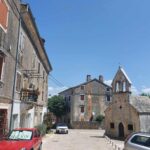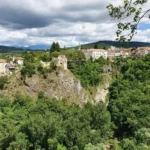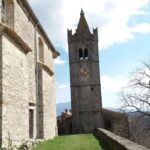Located on a hill raised from the valley of “Limska Draga”, Dvigrad is mysterious and ancient.
Mystical Dvigrad or Dvograd, Dvegrad or ” Duocasteli ” at first glance leaves the impression of a ruin. Realistically, it is. However, entering the remains of the former fortress at the bottom of Lim Channel, we will discover that its streets still hide many stories and legends that have been “passed down for generations” by the hearth.
These are stories that tell of one of the most complex ruins of medieval castles in Istria. Although it was first mentioned at the turn of the 9thand 10thcenturies, under the name Monte Castello or Moncastel, today’s Dvigrad has been inhabited since prehistory – the Bronze Age. The same was made possible by the sources of drinking water under the forts visible to this day.
A walk through Dvigrad is… listening to the secrets of the walls
The area of the castle, which means ” Two Cities “, originally consisted of two separate forts: Castel Parentino (the name of the local hill) and the fort Moncastello. Although today we see only the remains of the ruins of Moncastello, this abandoned medieval town is one of the most fascinating attractions in Istria. Dvigrad, which has been inhabited from Illyrian times to the 18thcentury, will reveal its secrets, which are primarily found in the courtyards and walls of houses, the ring of city walls, the defensive tower, the remains of the imposing church of St. Sofia, the square and the palace. It is no coincidence that Dvigrad originated in the Lim Channel (then called Limes). This strategic border of the road between Pula and Trieste enabled that fort would play an important trade role and balance between the north and south of the peninsula.
Three city gates and walls
Although the city gate is the entrance that will take us into the mystical area of streets that were once inhabited by “Dvegrajci “, to get to the top of the fortress will need to cross another or even two city gates. Their main feature is arched passages, and double defensive walls, often damaged by the ravages of time.
Abandoned streets, courtyards and views
Courtyards, houses, and barns, in most cases, demolished, hide the secrets of the medieval castle, which is formed by the junction of the Parentino and Moncastello forts, spread over 16,000 square meters of a hill. Today visible remains with a beautiful view of the Lim Channel testify that during the Venetian Republic the then Duocastei or Duo Castro served as a defensive castle.
The streets of today’s town are eerily empty. But that does not mean that they do not hide their past when battles were fought for them between Aquileia, Austria, Genoa (1354), and the Venetians (1413). The arrival of the Venetians, like in most other Istrian towns, will bring glory. Yet, as it fails to resist the scourge of epidemics that are increasingly knocking on Europe’s door, that glory will not last more than three centuries.
Walking through the streets of Dvigrad, we are left to imagination and emptiness at the same time. The first helps us to imagine life as it once was here, while the latter gives us an account of the current situation. And that Dvigrad once had splendour is best shown by the remains of the Basilica of St. Sofia, which dominates the ruins. The church from the 5thcentury was built as a single-nave early Christian Basilica and was later converted into a three-nave basilica. The church, which is often a motif in the photographs, is supposed to have been abandoned in 1714. Relief with the image of St. Sofia, which holds two cities in its arms, is today located in the parish church of the nearby town of Kanfanar.
Learning about Dvigrad means…uncover the legend of the plague and Morgan’s treasure
Although the streets of Dvigrad today exude the fresh sea air of the Lim Channel, they were once plagued by an epidemic. After the Uskoks managed to enter Dvigrad in 1615, the Venetian Loredan rebuilt the fortress with great losses. This event means a great turning point for Dvigrad and throws it on the road without return.
The population at that time was very insecure, and with epidemics of malaria and plague, the city was having a hard time coping. The same is evidenced by the legend that one night in 1630 the plague entered the city. It has since been overgrown with thorns and ivy. It is home to snakes and lizards, and at night you can often hear the sound of falcons, owls and who knows who. Dvigrad is considered one of the best-preserved abandoned cities in Central Europe, which was not destroyed by war, or fire, but by an epidemic. An interesting text about the same was written by Josip Bratulić:
“There are numerous ruins of towers, castles and forts, but only one is Dvigrad – it was not destroyed by military force or fire, but was abandoned and left to a solitary death. Today, it remains on the hill as a warning to travellers and a reminder to visitors who came as guests to understand what Istrian medieval towns once looked like”.
The legend of the plague
The night hides legends, whose characters are awakened from sleep, especially during the full moon. According to one of them, the plague entered the city during the evening and destroyed everything. Only one young man who was a shepherd was saved. While he was guarding the sheep outside the walls, an unknown woman approached the young shepherd a few days, introduced himself as a plague, and said
- No one will survive in the city tonight. If you know any of your own, take him and flee –
So the young shepherd managed to escape with his mother, brother and sister, and from the shepherd’s stories, a nearby place of Kanfanar emerged. The story of the “plague”, which could have been an “easy woman”, has been passed down for generations.
The legend of Morgan’s treasure
Everyone who wanders in search of treasure will find a legend from the nearby town of “Mrgani” on the streets of Dvigrad. When the famous pirate Captain Henry Morgan sailed into the Adriatic with his crew, he was forced by a storm to anchor his ship on the shores of the Lim Channel in an escape from it. Then he discovers the walls of Dvigrad, built on the hill of the canal.
Realizing that the city has been abandoned, he decides to hide his treasure next to the upper tower. To this day, we do not know if the captain ever returned for his treasure. Perhaps a full moon visit is one way to find out the truth of this legend.
To fully experience Dvigrad…explore the surrounding churches and visit the “Dvigrad Fair”.
The question we often ask is how much the mysterious city can still witness the time as it once was. To get the final answer one should visit this place of hidden legends at one of the events that are an ideal opportunity to visit. One of them is certainly the “Dvegrajski samanj “, which is held every year in late May.
Churches in the vicinity of Dvigrad
The town that still records a period of decay shorter than the time of its creation today may be physically but not surrealistically empty. Today it attracts visitors not only to its mystical streets but also to the surrounding churches.
The small church of “Sv. Marija od Lakuća” (St. Mary), whose walls are decorated in shades of purple, red, green and orange, is located below Dvigrad. With a canopy on the façade and an apse painted with late Gothic frescoes from the 15thcentury, an interesting detail is a ciborium located above the entrance below the bell tower. The interiors of the church are decorated with frescoes of the ” Colorful Master “, named after the characteristic range of colours: cadences of purple, red, green and orange tones. It is worth stopping and looking at the “Chapel of St. Elijah, also known as the “Thunderer“.
The single-nave stone building at the bottom of the bay dates back to the 15thcentury. It has an apse and an altar. Traces of frescoes are visible, but unfortunately not recognizable. The church used to serve pastors as well. A very challenging climb towards Vidulini with a beautiful landscape will discover the church of “St. Agate” dating backto the 10thcentury. A single-nave building with a polygonal apse of the Byzantine-Ravenna type depicts a herringbone motif. It is a characteristic of medieval architecture in Istria. The church also hides frescoes from the period of early Romanesque wall painting, characteristic of paintings of Benedictine art.



